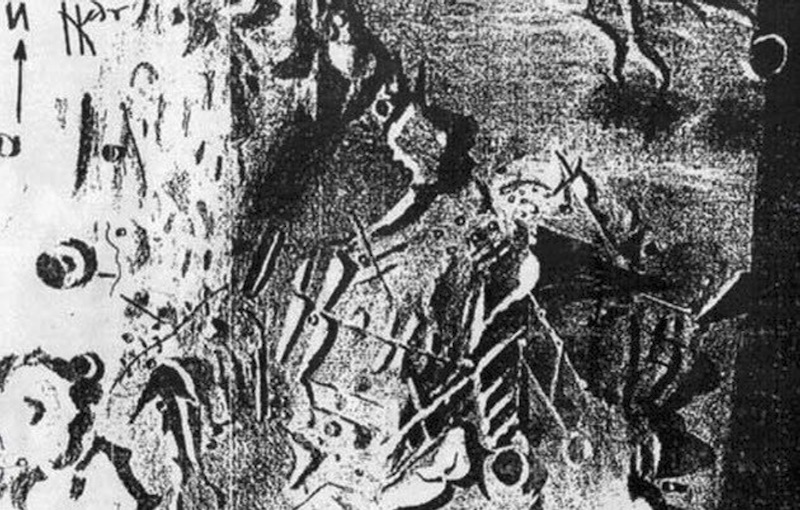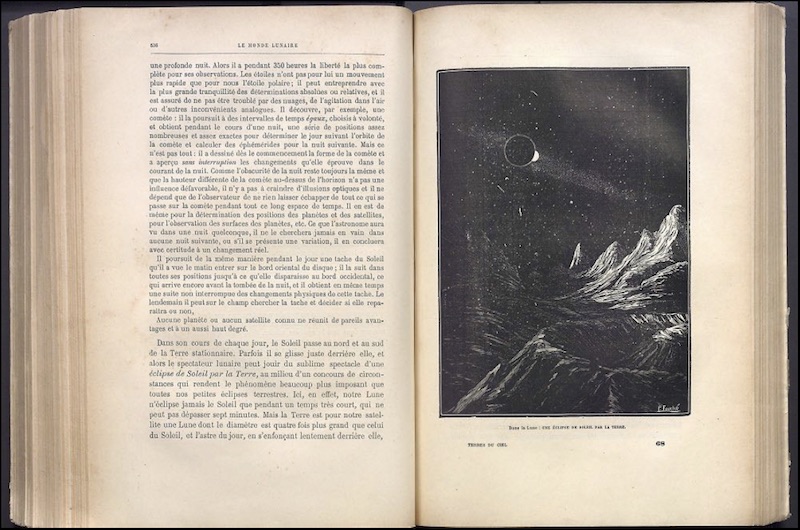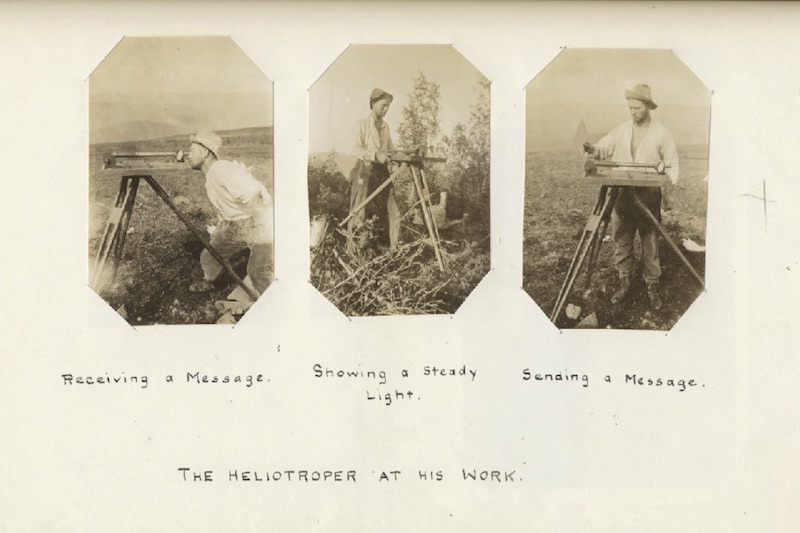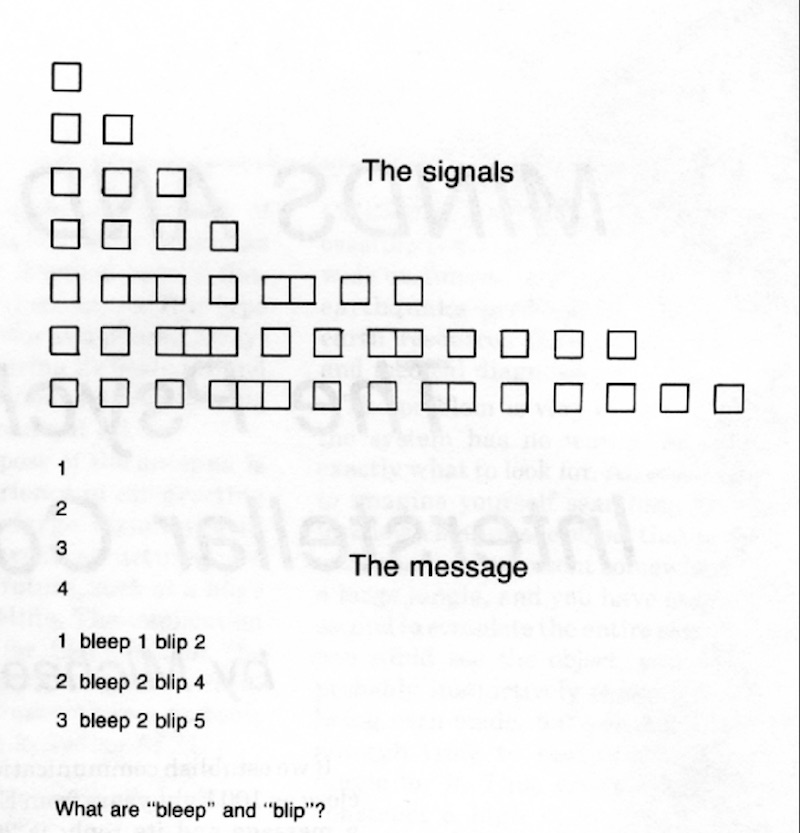Alien Media, Literally
Alien Media, Literally
What follows is a history of the media formats developed to communicate with extraterrestrial life. It takes on the style of an old Twilight Zone episode, where we seem to be on an alien world but we turn out to have been Earth the entire time.
When we think of alien communication, we tend to think of what is called “Passive SETI” (Search for Extraterrestrial Intelligence), the process of listening passively for seemingly significant signals: the enormous dishes of radiotelescopes turned to the sky, soaking in cosmic noise through which we look for something regular, structured, strong. This is a very apt form of media for the theme of the “ever elusive” at transmediale 2017—sifting a Sahara of stellar activity and looking for a few grains that might correspond to a deliberate sign, which could take the form of anything from the digits of pi to the frequency of an excited hydrogen atom. But I would like to turn our attention to something even more elusive and challenging: “Active SETI,” the challenge of actively signaling to and communicating reciprocally with the alien.

Consider the hypothetical process of communicating with an entity that is not only nonhuman, in the sense of a dolphin or a sycamore or a starfish, but whose reasoning, media, and anatomy are entirely unknown. Anthropologists who study the subculture of scientists in the field of extraterrestrial communication call the focus of these scientists “the missing subject.” We can assume that these “missing subjects” share the physical universe with us, which distinguishes this work from apophatic or negative theology. Aside from that, how does this work begin? What is its medium? What is the format of communication—that is, how do we imagine the message we send could be interpreted by whatever receives it? It's an encoding/decoding problem, a media problem, on a cosmic scale.
As we began to conceive of non-supernatural life elsewhere in the universe, the initial communication proposals were charmingly straightforward: assume that the communicants are basically human. Below is a drawing by the wonderful Franz von Paula Gruithuisen, a superb early 19th century astronomer given to wild flights of fancy, for whom the cosmos was basically the outskirts of Earth, populated by creatures very much like us.

This is one of his drawings of a city he discerned on the Moon. He imagined the Moon's inhabitants something like the ancient Egyptians, with terraced agriculture and attachment to monumental pyramidal construction, with a presumably melancholy temperament brought on by all those eclipses.
He was convinced that the famous “ashen light” observed on the cloud cover of Venus was the product of “general festivals of fire given by the Venusians,” with the 47 years between its appearance reflecting "the reign of an absolute monarch" before “another Alexander or Napoleon comes to supreme power on Venus.”
This introduces one approach: using light, and more generally visual media, to communicate with neighboring extraterrestrials. Camille Flammarion—an astronomer, science fiction writer, and psychic researcher—was, in the 1860s, one of the first to begin imagining experience from the position of the alien, trying to make fewer presuppositions about their consciousness or perception, leading to a communication model that started with the minimal signal to convey intelligence through light signaling. His proposal was for vast tracts of electric lights strung across the Sahara, shining upwards when Mars was in opposition, laid out in geometric shapes to distinguish our deliberate activity from a forest fire, a volcanic eruption, or a bioluminescent sea. He saw the possibility of interplanetary communication as of one aspect of other developments in media technology; after the wonder of the phonograph, could Martian conversation be far behind?

His colleague, the mononymic turn-of-the-century astronomer Mercier, suggested an enormous mirror, to be built in the heart of Paris and lit with electric light (on the Champ-de-Mars, no less). I would love to have sat in on the public hearing for the proposal to build the brightest light on Earth, at the scale of a football stadium, in the heart of the city. Mercier saw this, again, as a minimal signal—a bright, persistent dot, like a bonfire in the wilderness, signifying our presence. But others were beginning to think about flashing lights, about codes. The mathematician Carl Friedrich Gauss suggested a colossal version of the heliotrope tool he invented in 1818, which employed a mirror to reflect sunlight to mark distances in surveying, for long-distance communication. He calculated that it could be done with 100 16-foot mirrors used together—these could, using flashes, initiate some kind of mathematical dialogue with aliens.

There were many variations on the proposal to create vast visible shapes: for instance, by digging geometric canals, filling them kerosene, and setting them on fire at night, or charging up auroras as interplanetary light shows, or planting an enormous tract of Siberia with multicolored wheat in the square of the hypotenuse. None of these were ever successfully built during the turn-of-the-century “Mars mania.” Would that they had; we could have a few relics of our hope for other life in the universe, as we have megaliths and standing stones from Paleolithic cosmology. As if anticipating Robert Smithson's earthworks on an enormous scale, a city-sized array of mirrors abandoned in the desert: a monument to the void.

But what else could be communicated, beyond the mere fact of our existence? Once grids of lights are in place, we can't just use Morse code. Furthermore, how do we distinguish human activities and attempts to communicate from the effects of natural events —eruptions, auroras, bioluminescent algae blooms, and the radio hubbub of the universe at large—for an unknown observer?
Charles Cros is now known primarily as the author of some delightfully frustrating poetry, and as one of media history's also-rans. He invented techniques for three-color photography in 1869 and a version of the phonograph in 1877—both just in time to be superseded by other inventors —and was part of the circle of artists and writers who shared the so-called fumiste attitude, combining outrageous subject matter with deadpan style that baffled outsiders. His whole career involved acts of deliberately failed communication with other humans—while, in his spare time, seriously considering the challenge of reciprocal communication with an alien intelligence.
Picking up on the idea of the enormous flashing mirror, Cros considered, first, how a sequence of rhythmic flashes could be used to encode numbers, but then took up the question of whether those numbers could in turn encode images. A series of digits could communicate binary pixels—black or white, off or on—in lines on an ordered grid. As he outlined his project, it becomes clear that to us know that he was developing a version of what is now called “run-length encoding,” an image compression and transmission technology akin to that used in fax machines, early digital bitmap images, and some of the very first television technologies.
In his 1869 essay Étude sur les moyens de communication avec les planètes, he wrote: “analogous notation procedures for rendering designs as number series are used in various industries, including weaving and embroidery […] There is, in [Jacquard weaving], a whole science that, as so often happens, was practiced before it was theorized.” (The Jacquard loom being a proto-computational machine, programmed with punch cards to output complex woven patterns, which directly influenced early computing hardware.) “From it will emerge a new and important branch of mathematics, and eventually a new classification of these primordial sciences. The study of rhythms will take its place alongside that of figures.” For rhythms, think algorithms! Patterns, logical operations, instruction sets. The project of alien communication, with its problems of abstraction, encoding, compression, error correction, and display, becomes analogous to the project of developing computation and digital media.
During the Second World War, the splendidly named Lancelot Hogben, a British zoologist and professor who specialized in the hormonal signals of African clawed frogs, developed “Interglossa," a proposal for an auxiliary language, akin to Esperanto, with an inventively simple structure: a kind of international argot of science and technology inspired by the complexities of teaching biology to a thoroughly cosmopolitan student body. In the 1950s, he began to seriously consider the conceptual problem of communication with extraterrestrial life, which he called “Astraglossa.”
Hogben started with the assumption that most minimal nonhuman communication could only consist of pulses (radio signals) and time. There was only the iteration of signals, the order of signals, and the gaps between signals. Some of these we can eventually arrange into operations—addition, subtraction, identity, affirmation and negation, and so on. Given enough time, the operations can be stacked into what he called “flashes” that constitute rules: apply the set of operations collected by this rule to the following string of numbers. Followed by silence. Which thus becomes the framework for a signal, a flash, corresponding to a question.
All of this should begin to sound rather familiar. In the midst of comparing his project to Mayan glyphs, to Otto Neurath's Isotype, to the symbol system of Charles Bliss, to childhood education and the education of Helen Keller, Hogben makes the contemporary link clear: “The only unmentioned clue that I regard as specially relevant to our theme I shall merely refer to en passant, viz. what we now call programming, i.e. the syntax of the language in which we transmit orders to the new electronic computing machines.”
The challenge of establishing a shared binary symbol system and a logic of operations, predicated on gaps, rank order, and iteration, very closely resembles the work being done by Alan Turing, Tom Kilburn, Freddie Williams and others to build Turing-complete electronic computers in Manchester and London contemporaneously with Hogben. In other words, the project of talking with aliens was coinciding with the problem of talking with machines. Hogben and his contemporaries understood it as a computational problem, a telecommunications problem, a media problem, rather than a language problem.

I'd like to close with one of my favorite people: the mathematician Hans Freudenthal, who published in 1960 what is easily one of the strangest books of the twentieth century, one of the most nonhuman books ever produced. Lincos: Design of a Language for Cosmic Intercourse documented Lincos, Freudenthal's encoding system, which meant to put “in principle the whole bulk of our knowledge” into a form communicable to any possible intelligent life.
Lincos is a language that begins with “peeps” of discrete radio pulses, which introduce the natural numbers and, in Hogben’s proposal, provide the fundamentals of the language. Once past the basics of numbers, spatial coordinates, timing, and simple logical and mathematical operations, Freudenthal worked out how to express things like assertions about the future, the concept of politeness, a short history of Fermat’s theorem, bets and gambling, the act of wishing, points and vectors, and the act of whistling for a dog, expressed entirely in his abstract, formal, binary notation.
To convey much of this, Freudenthal described a set of fictional human actors named Ha and Hb who embark on a series of logical-minimalist playlets to tell stories about the nature of the world and human experience in its most austere form, to an interlocutor who knows nothing about it. They are somehow heartbreaking, like Beckett plays reinterpreted by machine learning.

Hb knows something but does not say it, which means that Ha does not know it, but Ha can try to guess what it is that Hb knows. Ha and Hb know what happened in the past but not what will happen in the future, and they bet on an outcome together. Ha throws a ball farther than Hb can catch it. There are many other entities also living in their world with whom they can't talk in the same way, even though those things can also see, hear, move, know the past, and chase a ball. Ha and Hb can die, and so can all the other things with which they share the world. They can wish that things were otherwise than they are. When one of them dies, they can no longer talk together.
Freudenthal’s project is filled with striking insights, but many of them seem less than practical for broadcast to Alpha Centauri. Many of his send-and-receive patterns are hundreds of steps long, which would be hard to realize over a distance of many light years—but they would work brilliantly as a formal schema of the world to train a computer. Freudenthal strove to write a step-by-step explanation of the human condition, the particular facts of being a person in the universe, for an entity that lacks anything but a memory and the input of a very limited set of electromagnetic signals. The audience for Lincos already existed as he wrote: not on Mars but in the showrooms of IBM and Olivetti.
No wonder Marvin Minsky was Freundenthal's student, friend, and passionate advocate. Minsky, who constructed the first neural network simulator, was drawn to this research because it shoots for the stars, and lands in the AI lab. Indeed, one of the persistent challenges of AI has been precisely in recognizing the particular biases and tendencies in human cognition that would not be shared by a machine—no more than the way we think that we see is shared or modeled by a sensor picking up photons.

With binary pulses, logical operations, and encoding and decoding schemes, we taught the Martians to make spatial sense of the world, keep secrets, recognize faces, hear and compress and filter voices, make conversation and guesses and deductions, and interpret a far broader range of electromagnetic radiation than just radio waves or the visual spectrum. The informational commerce and exchange of the world now takes place in the dense network of Martian canals that we've dug for the last sixty years, and we communicate in ways that embody the problems and solutions of Cros and Gauss, Hogben and Freudenthal. I would suggest, in other words, that the history I've been telling you is the history of our present, and that we built all the aliens ourselves. The challenge is now to understand, clearly and precisely, the alien and nonhuman condition of the machines we’ve built as our interlocutors and infrastructure, and to learn to approach them on their terms.


